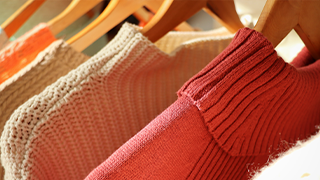Sweater Manufacturing Basics
Sweater Manufacturing Overview
Machinery
The primary type of knitting for sweater manufacturing is weft knitting. Machine gauges tend to be coarse (7 to 14 gauge) and in a flat-bed arrangement. Circular machines are also used for a high production rate in cut-and-sew production. Today’s fully electronic V-bed machines can produce whole garments not requiring any cut and sew. With flat-bed machines, needle manipulation allows for transfer stitches, split stitches, and bed racking to shape and enhance sweater panels.
Cut & Sew
Cut and sew is the most common method for manufacturing sweaters. It is preferred because it allows a high production rate and reduces waste by making it possible to work around fabric defects. By the cut-and-sew method, sweater fabrics can be produced that use the full width of the needle bed of a flat-bed machine or the full diameter of a circular machine. Normally, several linear yards of fabric will be produced as one piece, from which the various panels of the sweater are cut.
Panel Knitting
Panel knitting is another commonly used sweater manufacturing method. This method involves knitting specific sections of the garment pattern, called panels. The panels are defined by the exact number of courses and wales needed for each size of the garment. During the knitting process, a separation thread is inserted between the panels, to allow them to be divided without cutting. Once the panels have been knitted, the separation thread is removed, and the panels are marked according to the garment pattern.
Full Fashion
Full fashioning and shaping during manufacturing eliminate the need for cut and sew. To shape the sweater on the knitting machine, the number of needles used during the knitting process is increased or decreased, to change the width of the fabric. Although full fashioning and shaping use the same manufacturing technique to create panels, the appearance of the resulting fabric differs. In full fashioning, transferring specific loops to adjacent needles to widen or narrow the fabric results in the formation of “fashion marks.” If fashion marks are not formed, the resulting sweater is called a “shaped” garment. Full fashioning provides a better fit and a smoother seam.
Knit-to-Wear Garment
In whole-garment knitting (also known as “knit-to-wear”), entire sweaters are knit without any cut and sew or linking, resulting in a ready-to-wear garment. The individual body and sleeve parts are knit in tubular form to the proper shape and then knitted together and connected on the machine, using widening, narrowing, and binding-off techniques, to produce a finished garment.

